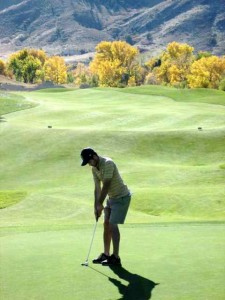Golf and Logic

Relax Elliot. It’s just a birdie.
Last week, I tweeted about the ability of golfers to make putts under different conditions. I claimed that even the best golfers have a loss aversion bias. Therefore, they’re more accurate when putting for par than for birdie. If they miss a par putt, they wind up with a bogey — a painful experience. If they miss a birdie, on the other hand, they often get a par — not so bad. The pain of getting a bogey is greater than the pleasure of getting a birdie. That’s pretty much the definition of the loss aversion bias.
Several of my friends who are golfers suggested that I don’t know what I’m talking about. For instance, my buddy Nick Gomersall wrote, “When you putt for a birdie you are more relaxed, nothing to lose and you stroke it in. Now when you putt for par you have negative thoughts as you think what happens if you miss and you put a bad stroke on it.” Nick is an excellent golfer and an all-round good guy but he’s wrong.
Here’s a link to a 2009 article on the topic, “Avoiding the Agony of a ‘Bogey”: Loss Aversion in Golf — and Business“. The authors, Devin Pope and Maurice Schweitzer, gathered data on 2.5 million putts taken in 239 PGA tournaments between 2004 and 2009. They note that “par” is an excellent divider between gain and loss. Better-than-par is a gain; worse-than-par is a loss. Loss aversion theory says losses are felt more deeply than gains. Thus, a bogey should bring more pain than a birdie brings pleasure. A golfer should try harder to avoid a bogey than to achieve a birdie.
And, that’s exactly what happens. The authors conclude, “…on average, golfers make their birdie putts approximately two percentage points less often than they make comparable par putts. This finding is consistent with loss aversion; players invest more focus when putting for par to avoid encoding a loss ….” Pope and Schweitzer used a number of statistical analyses to control for variables such as distance from the hole, the player’s overall skill, confidence, nervousness, and so on. The only explanation seems to be loss aversion.
Loss aversion is essentially an illogical bias. Why does it occur? According to Schweitzer, “”Loss aversion is the systematic mistake of segregating gains and losses — evaluating decisions in isolation rather than in the aggregate — and over-weighting losses relative to gains…”
Golf, it seems, can teach us a lot about business and finance. To avoid loss aversion, you need to look at the big picture. In golf, that means your position in the tournament rather than your position on the green. In investing, that may mean focusing on your entire portfolio rather than the gains or losses of an individual stock on an individual day. As Monty Python points out, “Always look on the bright side of life.”
Totally agree with you that losing has more fear and emotion attached than winning. This is the typical gambler where sometimes they bet as they get a rush from the fear of losing. Then you look at penalty shoot outs in soccer matches ( football over here (:- ) how many times do you see great players miss them under pressure. So when it comes to golf I am very interested in your statistics and this is why.
Golf is a mental game and I play off 5 which is pretty good. Putting is the hardest thing to do in golf as the club needs to be taken away smoothly which most golfers find hard to do.
On short putts whether for birdies or par I use NLP what I do after lining up the put is to try to relax. Loosen the grip , breath slowly and then just before I hit the ball I switch my mind off by thinking of a boat on the water sailing down the river.
Then I hear the ball hit the cup and I pick it our of the hole. So I am not even thinking this is for a par or birdie as I am switching the one thing off that you have to when putting , the conscious mind.
On long putts you are never trying to hole them just trying to get the line and the pace. In my mind I see the hole as I watch the club hit the ball. NLP again.
So I would disagree with your article from my experience of golf . Plus the statistics that are measured on the pro circuit are putts from inside 10 feet which I suspect there are more par putts than birdies in a round which might explain your numbers
Great articles Travis one of the few posts that I read regularly on Linked In keep them coming
Nick